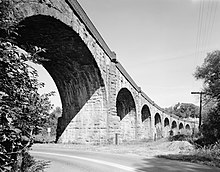Thomas Viaduct
| Thomas Viaduct | |
|---|---|
 |
|
| Coordinates | 39°13′18″N 76°42′48″W / 39.22167°N 76.71333°WCoordinates: 39°13′18″N 76°42′48″W / 39.22167°N 76.71333°W |
| Carries | Railroad |
| Crosses | Patapsco River |
| Locale | Elkridge, Maryland |
| Owner | CSX Transportation |
| Heritage status | NRHP 66000388 |
| Characteristics | |
| Design | Arch bridge |
| Material | Patapsco granite |
| Total length | 612 feet (187 m) |
| Width | 26 feet 4 inches (8 m) |
| Height | 59 feet (18 m) |
| Longest span | 58 feet (18 m) |
| No. of spans | 8 |
| History | |
| Designer | Benjamin Henry Latrobe, II |
| Constructed by | John McCartney |
| Construction begin | 1833 |
| Opened | July 4, 1835 |
|
Thomas Viaduct, Baltimore & Ohio Railroad
|
|
| Area | 0.5 acres (0.20 ha) |
| NRHP Reference # | 66000388 |
| Added to NRHP | October 15, 1966 |
| References | |
The Thomas Viaduct spans the Patapsco River and Patapsco Valley between Relay and Elkridge, Maryland, USA. It was commissioned by the Baltimore and Ohio Railroad (B&O); built between July 4, 1833, and July 4, 1835; and named for Philip E. Thomas, the company's first president.
At its completion, the Thomas Viaduct was the largest bridge in the United States and the country's first multi-span masonry railroad bridge to be built on a curve. It remains the world's oldest multiple arched stone railroad bridge. In 1964, it was designated as a National Historic Landmark.
The viaduct is now owned and operated by CSX Transportation and still in use today, making it one of the oldest railroad bridges still in service.
This Roman-arch stone bridge is divided into eight spans. It was designed by Benjamin Henry Latrobe, II, then B&O's assistant engineer and later its chief engineer. The main design problem to overcome was that of constructing such a large bridge on a curve. The design called for several variations in span and pier widths between the opposite sides of the structure. This problem was solved by having the lateral pier faces laid out on radial lines, making the piers essentially wedge-shaped and fitted to the 4-degree curve.
The viaduct was built by John McCartney of Ohio, who received the contract after completing the Patterson Viaduct. Caspar Wever, the railroad's chief of construction, supervised the work.
The span of the viaduct is 612 feet (187 m) long; the individual arches are roughly 58 feet (18 m) in span, with a height of 59 feet (18 m) from the water level to the base of the rail. The width at the top of the spandrel wall copings is 26 feet 4 inches (8 m). The bridge is constructed using a rough-dressed Maryland granite ashlar from Patapsco River quarries, known as . A wooden-floored walkway built for pedestrian and railway employee use is four feet wide and supported by cast iron brackets and edged with ornamental cast iron railings. The viaduct contains 24,476 cubic yards (18,713 m3) of masonry and cost $142,236.51, an estimated $2,769,917.36 in 2007 dollars.
...
Wikipedia

